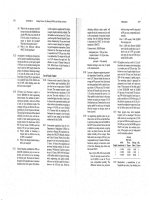Book reviews book essays 0015 0015
Bạn đang xem bản rút gọn của tài liệu. Xem và tải ngay bản đầy đủ của tài liệu tại đây (167.5 KB, 1 trang )
in the ethnolinguistic dictionary Slavianskye
drevnosty [Slavic Antiquities]. M. Valencova
clarifies that although the tradition of demonology remains, a true faith in demons has
been disappearing. As a result, supernatural beings are perceived more in the relationship with
the man rather than with nature, this concerns
mostly the concepts of jinx, hex, or malefice
(p. 43 and 48). The image of demons in folk culture becomes blurry (upír or víla, for instance)
and the way their role is viewed has shifted from
bad demons to peaceful or helpful ones (e.g.,
svetielka), but also vice versa (zmok in villages
Bobrov and Liptovská osada, pp. 47–48). Nevertheless, the author adds that values like family,
society, and tradition are stable and remain unchanged.
In Ľ. Gábor’s article titled Metaforická projekcia cnosti v slovenskom jazyku z pohľadu etnolingvistiky [Metaphorical Projection of Virtue
in the Slovak Language from an Ethnolinguistic
Point of View] there is an analysis of a cognitive
view of the abstract notion of cnosť/čnosť
(virtue). The introduction focuses on the etymology and basic definitions of this notion,
which is followed by the types of cognitive and
conceptual metaphorical structures that include cnosť/čnosť with the national Slovak language corpus as a source. Based on his research,
the author concludes that virtue is understood
as a semantically positive value but what is considered as virtuous remains highly individual.
Ľ. Gábor therefore finds it impossible to establish a detailed definition of this value. The individual performatives of virtue in a person’s
life are connected with positive connotations.
However, virtue can also be found in the context
of sarcastic or critical comments regarding
a value mind-set. Virtue is not exclusively
viewed as a value, sometimes it can also be
found in the context of human skills, characteristics, or means to perform specific actions.
S. Kmecová studied the house/home as one
of key concepts of the linguistic worldview in
each culture. As stated by the author, this concept has been studied fairly extensively within
Slavic linguistics (see Barmiński, 2008; Pintarić,
2007; Avramova, 2007 and others). Her article
focuses on the Slovak-Slovenian comparative
aspect. She studies how the concept of house/
ht tps : // d oi. or g./ 1 0. 2 47 8 /se - 20 2 1- 0 0 26
home is anchored in Slovak and Slovenian
paremiological units. The author emphasises
that house and home are closely knit as concepts, which has been proven by phrasemes
containing parts of a house (threshold, roof,
hearth, fireplace, furnace) each of which cocreates the symbolism of a house being a home.
The concept of a home is inseparably connected
with the concept of a family, which is why the
author states proverbs including the components žena, muž, dieťa (woman, man, child)
whose semantics gives reference to their traditional role within a household. This way the
author expanded her research subject which
has been the woman in Slovenian and Slovak
phrasemes (see Kmecová, 2018, 2019 and
others). The presented phraseological material
confirms the idea of a home as a sacred space
that represents a top human value and is connected mainly with positive connotations.
In their joint study, P. Žeňuch and M. Strýčková present several projects which reflect specific cultural aspects of Byzantian and Latin
texts as a part of the national and confessional
tradition in Slovakia. The existing research has
proven that the Byzantian written and spiritual
tradition forms an inseparable part of Slovak
B oo k R ev iew s / B o o k Essa ys
461









